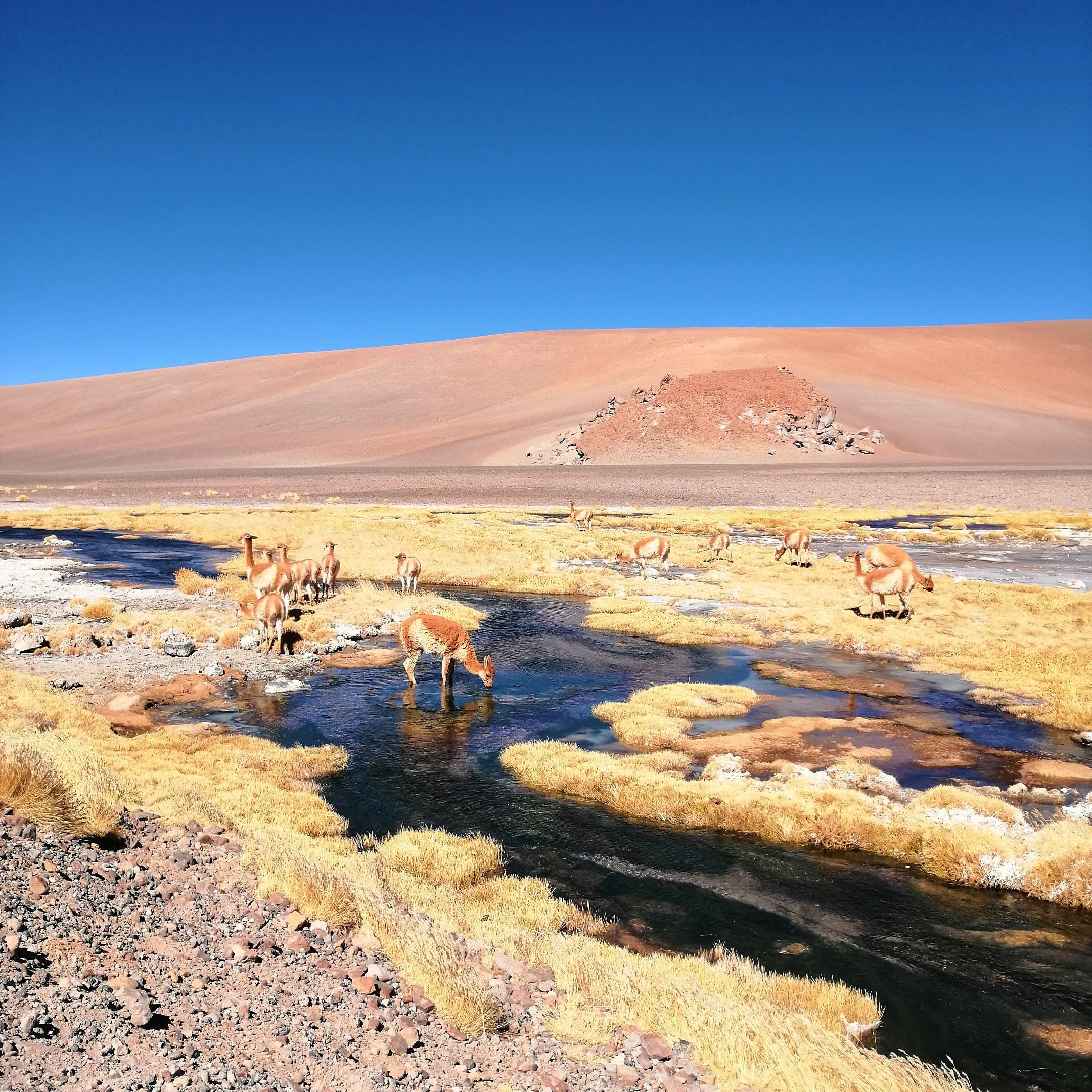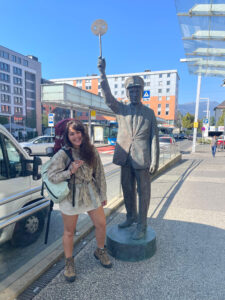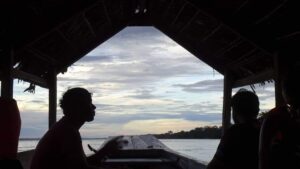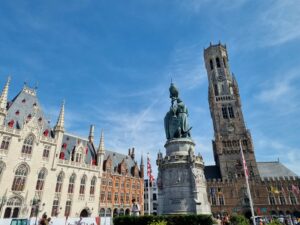Two friends and I embarked on a journey to explore the driest desert on Earth, a place rumored for its stark beauty. Intrigued, we set out to check it out ourselves…
…and upon arrival, we were speechless. The vast expanse of the Atacama Desert unfolded before us, a landscape sculpted by wind and time. Volcanic peaks pierced the azure sky, and the arid plains stretched towards a horizon painted in fiery hues of sunset. San Pedro de Atacama, we quickly realized, lived up to its reputation – according to me, it rivals Patagonia as the most beautiful spot in Chile.
How to get to San Pedro?
Coming from Uyuni:
Fresh off exploring the surreal landscapes of Salar de Uyuni? Many continue their adventure to San Pedro de Atacama. The usual way to get there is with a multi-day tour from Uyuni, Bolivia. Hundreds of companies offer 3-4 day tours that take you through the Salar de Uyuni and end in San Pedro de Atacama. These tours handle border crossings and transportation to the town center.
Flying in from Santiago:
This is what we did! We found a great deal on a round-trip flight (around $60) to Calama Airport during the off-season. This flight only took about two hours, and Calama Airport is the closest airport to San Pedro de Atacama (just a short transfer away).
You can determine your means of transportation (bus, flight, drive, …) with Rome2Rio.
How to get from Calama to San Pedro de Atacama?
By rental car: Several car rental companies operate at Calama Airport. Do your research beforehand to compare prices online and be prepared to negotiate for the best deal. Renting a car gives you the freedom to explore the surrounding areas at your own pace, but be sure to factor in gas prices and consider an SUV or 4×4 vehicle for some of the terrains. When we were making the deal for the rental, we asked for a discount … and got it. Yay us! The final price for 5 days was 169 000 CLP ( +- 220 EUR) for an SUV + 4×4 car.
By bus/public transport: The bus terminal is located in the city center, where you’ll find frequent buses heading to San Pedro de Atacama. There’s no need to book a bus ticket in advance, as there are frequent departures throughout the day.
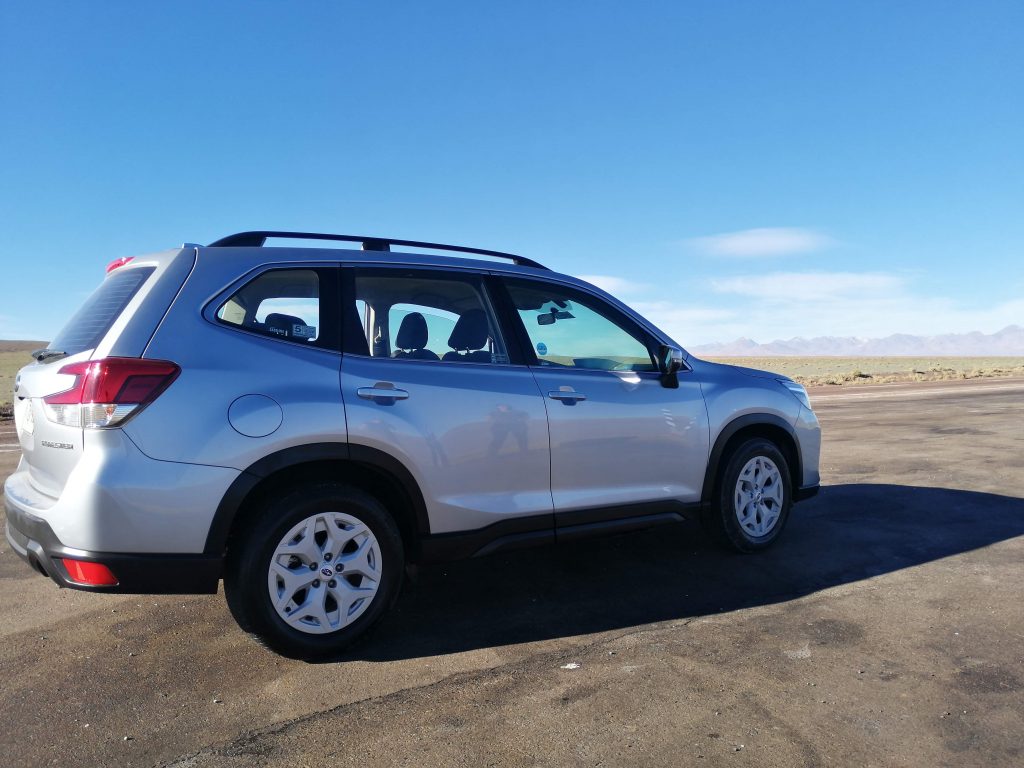

Why a rental car?
Since we explored by rental car, I can only offer tips for that travel style. I met many people who opted for different approaches – bicycles or tours. Biking San Pedro sounds amazing, but keep in mind the warm daytime temperatures and those many, many climbs! If you’re set on a cycling adventure, I recommend Valle de la Luna and Valle de la Muerte for their beauty and accessibility.
Now, about tours… San Pedro de Atacama is a Chilean tourist hotspot, and tour companies know it. Let’s just say, tours can be REALLY expensive, especially during peak season. Here’s the kicker: with the rental car and gas costs shared between the three of us, we saved a significant amount compared to tours. We explored everything San Pedro has to offer on a much tighter budget. Plus, there’s a good chance you’ll meet fellow travelers at your hostel who’d be happy to split the gas or even chip in for the rental fee!
Day 1 – Calama to San Pedro
We collected our rental car from Calama Airport and set off on the scenic afternoon drive to San Pedro de Atacama. En route, don’t miss the chance to stop at Cordillera de la Sal, a mountain range with a captivating display of colorful rock formations. This natural wonder offers a remarkable first glimpse of the otherworldly landscapes that await you in San Pedro de Atacama – peaceful, beautiful, and undeniably impressive. Take a moment to soak it in, snap some photos, and stretch your legs before continuing your journey.
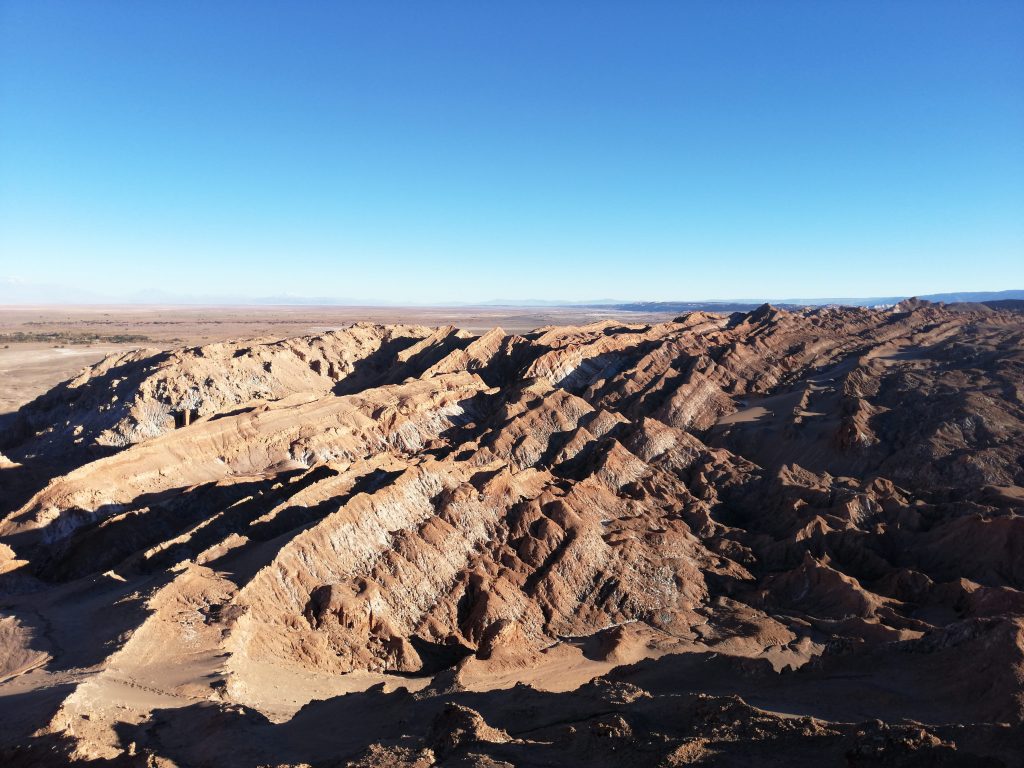
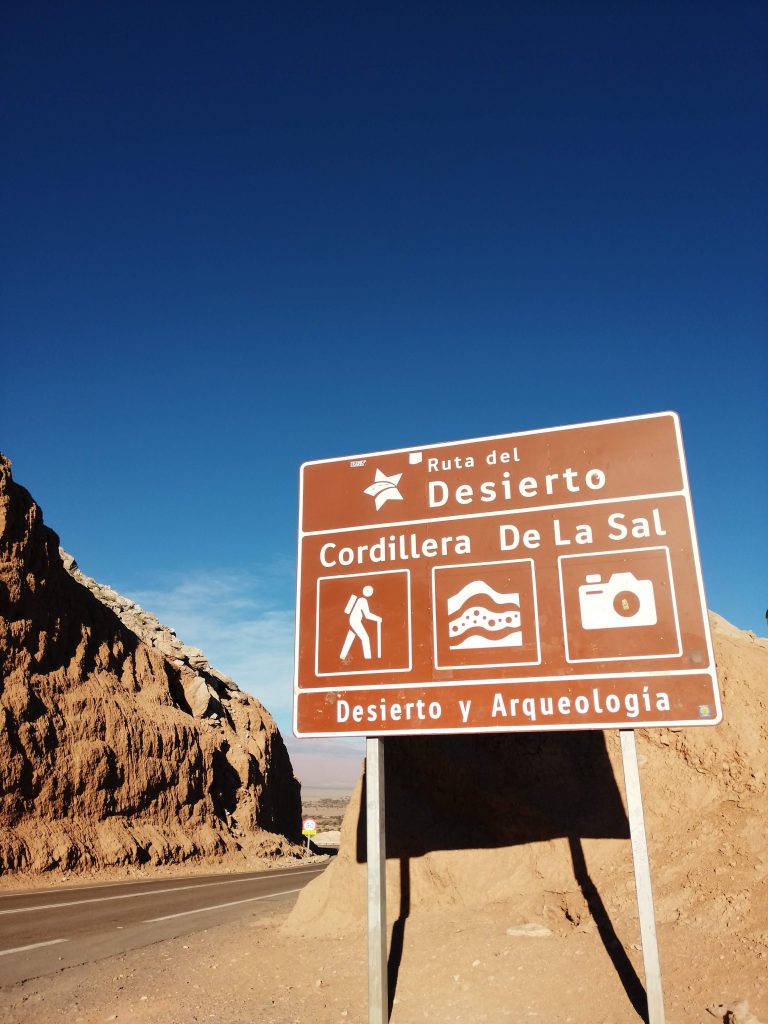
After stocking up on supplies, we unpacked and prepped some lunch for tomorrow’s adventure. To cap off a fantastic first day, we joined the hostel’s caipirinha evening. Great start to our trip. 😉
Day 2 – Ruta 27
Fueled by a breakfast and the excitement of a new adventure, we departed from our hostel around 10 am, together with two Germans we met in the hostel. On this day, we’d be driving on Ruta 27 towards ‘Reserva Nacional Los Flamencos‘. Before reaching the national park we made several stops:


– Vulcano Licancabur: Towering above the landscape at an impressive 5,920 meters, Licancabur volcano demanded our attention. We parked the car and ventured closer on foot, the vastness of the desert stretching out before us. Reaching a small canyon, we reveled in the view and captured some unforgettable photos.
– Mirador Quebrada Quepiaco: We bypassed the official viewpoint and pulled over a little early, rewarded with a breathtaking panorama. The rugged landscape unfolded before us, dotted with graceful vicuñas. We soaked in the beauty for a while, snapping pictures and marveling at the scenery.
– Laguna Pujsa: The allure of Laguna Pujsa beckoned us down an off-road track. While the drive itself was an exciting adventure, the lagoon itself wasn’t the most spectacular sight. If you’re not comfortable with off-road driving, you won’t miss out on too much by skipping this stop. For those who are adventurous, a 4×4 vehicle is recommended.
– Reserva Nacional Los Flamencos: “Our final destination for the day was the Reserva Nacional Los Flamencos, located just after a sharp bend in the road. You’ll see this sign:

Drive further to see some impressive rock formations and even further to get to the Monjes de la Pacana. (Be careful while driving there & avoid it with a normal car).
From here you could reach Salar de Tara, which is yet another long way off-road. We never got to the actual lake since we were getting tired of driving off-road, and we were also losing a lot of time to see other places. So, we decided to head back to the main road. From the main road (Ruta 27) we continued to drive toward the border of Chile and Argentina, where we passed two other lakes.
We paused to admire Laguna Aguas Calientes and Laguna Quisquiro, each with its unique charm. After taking in the beauty of the lakes, we decided to head back towards San Pedro de Atacama to find a spot for sunset viewing. Keep in mind that this route can be quite long, so it’s best to factor in travel time, especially as daylight fades. Of course, I recommend getting as close to San Pedro as possible before nightfall for safe travels. We found the perfect spot to watch the sunset: we stopped again at the majestic Licancabur volcano.
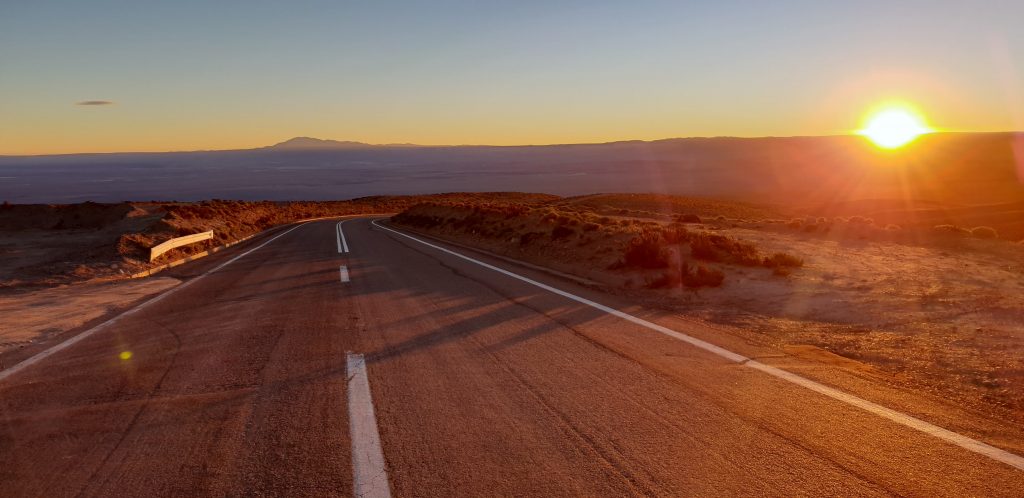
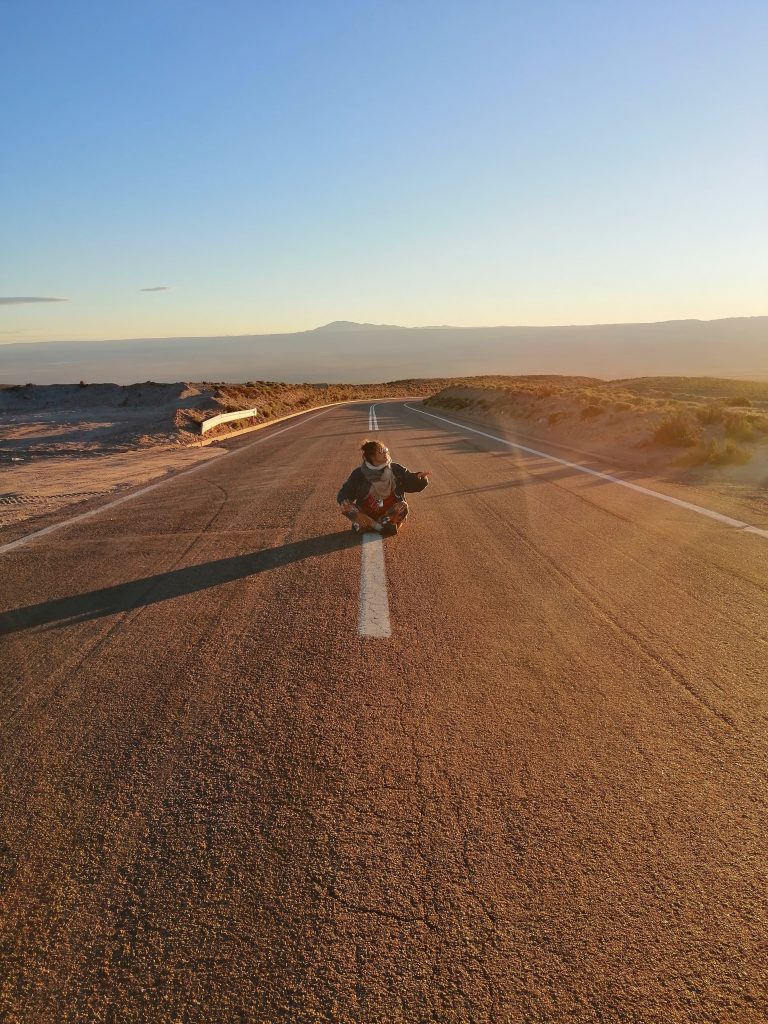
Day 3 – Ruta 23 and Salar de Atacama
On our second day exploring, we decided to head southeast on Ruta 23. Our ultimate destination for the day was Piedras Rojas, known for its stunning red rock formations. Knowing it was a long drive, we planned a stop on the way. With the hope of seeing flamingos on Day 1 dashed (we mistakenly thought they’d be at any random lagoon!), we were starting to lose hope of encountering these beautiful pink birds.
While driving towards Piedras Rojas, we reached Salar de Atacama – a perfect pit stop! This was our “mission accomplished” moment – we finally found flamingos! The entrance fee to Salar de Atacama is 2500 CLP (2019), and you’re greeted by park staff who are passionate about conservation. Curious, we peppered the entrance guy with questions, and he generously offered us a mini-tour. We learned a lot about the different animals living in the Salar, their diet, breeding habits, and more. We ended up spending a relaxing 1.5 hours in the park. Feeling welcomed and comfortable, we decided to enjoy our pre-packed lunch there, soaking in the beauty of Salar de Atacama.


Fueled by our flamingo encounter, we hopped back on the main road and passed through the town of Tocanao. Unfortunately, upon reaching what would have been our final stop, Piedras Rojas, we were informed it was closed. Determined to at least see it from afar, we followed the advice of the locals who had warned us and found a viewpoint with a decent view. Even though we couldn’t enter Piedras Rojas itself, the detour wasn’t a complete loss.
With a slight change of plans, we began our journey back to San Pedro, but not before a few more exciting stops! Our first stop was Laguna Miscanti & Laguna Miniques, a breathtaking sight with two high-altitude lagoons. (The regular entrance fee escapes me, but as a student studying abroad in Chile, I scored a discount – student price is 2500 CLP for your reference.) A quick tip for anyone following our route: Keep your eyes peeled for foxes while driving towards the entrance. Remember to admire these beautiful creatures from a distance – please don’t feed or touch them, for their well-being and yours.


Just outside the park exit, there’s one more jewel waiting to be discovered: Laguna Ojas de Salar and Laguna Tebinquiche. This spot is perfect for capturing the sunset’s magic in photos – don’t forget your camera! Here’s a heads up: since it’s on an unpaved road and takes time to reach San Pedro from there, be mindful of the time and avoid driving in the dark.
Back at the hostel, it was time to gear up for our stargazing adventure – the only tour we booked, since navigating the night sky requires some expertise! My advice for stargazers: check the lunar calendar beforehand (full moons can wash out the starlight), and dress warmly for the cool desert evenings. While I won’t recommend the specific company I used since I wasn’t entirely impressed, there are many reputable tour agencies in San Pedro de Atacama to choose from.
Day 3 – El Tatio Geysers & Caspana
Day three was kind of rough. We left at 3 am and drove a long way in the dark towards El Tatio Geysers. It was a 2h30min drive from our hostel and was completely dark. Because of the dark skies, we were able to pull over and marvel at the breathtaking night stars – because we just couldn’t get enough of the stars after our stargazing tour. 😉
We arrived at the geyser park entrance around 5:30 am. Thanks to our student IDs, we scored a discount on the entrance fee (4000 CLP per person – 2019 -). Once inside, drive to the back for the parking area. There were two major advantages to our early arrival: first, we practically had the place to ourselves, avoiding large tour groups. Second, and even more impressive, the colder temperatures resulted in the geysers being at their most active. The sight of the hot geothermal springs interacting with the frigid air was truly spectacular! Speaking of frigid, let me emphasize really cold. At -17 degrees Celsius, our hands and toes were put to the test. Bundling up warmly is essential! Another advantage of arriving early is witnessing the geysers transform throughout the morning light. We saw them first in complete darkness, then bathed in the magical hues of sunrise, and finally illuminated by the bright morning sun. As the sun climbed higher, temperatures became much more bearable, so the early discomfort was well worth it.



On the way back from the geyser field, keep your eyes peeled for another route branching off the main road within the park. This path leads to additional geysers and a hot spring. While the hot spring itself might not be the most luxurious experience (the water isn’t scorching hot, and there can be quite a few onlookers), it can still be an interesting addition to your visit.
After leaving El Tatio, we decided to play it by ear and explore the surrounding area. A quick look at our map led us towards a town called Caspana. Despite its remote location, the town was surprisingly well-maintained, even boasting a museum and a cultural center. Unfortunately for us, it was Monday, and both these facilities were closed. While I can’t share any museum insights, I can tell you the drive to Caspana was absolutely breathtaking! We practically had the entire road to ourselves, encountering barely a single car along the way. The scenery was stunning, and we spotted a variety of wildlife – foxes, donkeys, horses, vicunas, llamas… the list goes on!

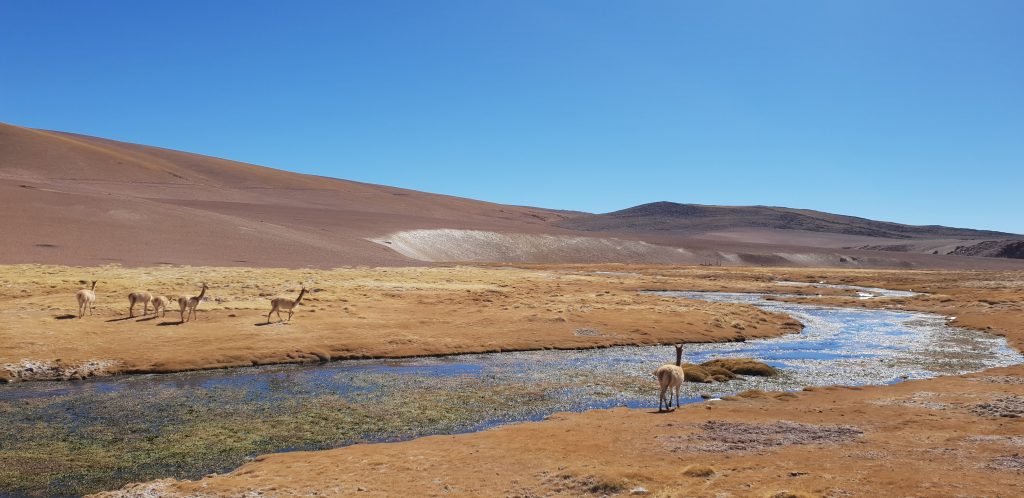
When we got back to the hostel we didn’t plan anything else in the evening as our day started rather early.
Day 4 – Valle de la Luna & Valle de la Muerte

After our early adventure at El Tatio, we decided to take it a bit easier on Day 4. Our destination was Valle de la Luna, a fascinating landscape close to the town center. Many visitors choose to explore the valley by bike – a great option to consider!
Upon arrival at Valle de la Luna, there’s an entrance fee (we scored a student discount of 2000 CLP per person). This fee also grants access to the viewpoint at Piedra del Coyote. Here’s a quick reference for low-season pricing. Here is a summary of the prices in the low season of 2019:

After soaking up the otherworldly beauty of Valle de la Luna, we continued to Valle de la Muerte (Death Valley), where we were entertained by the sight of people attempting (and sometimes failing!) to sandboard – a hilarious spectacle! Our final stop of the day was Piedra del Coyote for sunset viewing.
Sunset at Piedra del Coyote: Aim to arrive around 5 pm to avoid the crowds. Tour buses tend to roll in around 5:30 pm, making the viewpoint quite busy. An earlier arrival allows you to snag a good spot for photos, enjoy the scenery in peace, and capture the magic of the moment without photobombers.
Alternative Sunset Option: If you prefer a less crowded viewpoint for sunset, consider heading to the Cordillera de la Sal instead. This location likely offers a more intimate experience due to its lower tourist volume.
Day 5 – Adios San Pedro!
Our desert adventure was coming to an end on Day 5. Since my Uyuni bus departed around 10 am, I had to say goodbye to my travel companions and head to the bus station.
The girls, however, weren’t quite ready to leave! They squeezed in two more exciting stops before their departure.
Their first stop was Tulor, considered the oldest archaeological site in Chile. Based on my friends’ enthusiastic reports, it’s definitely worth a visit for anyone interested in history.
After Tulor, they drove to Calama, where they met their tour guide at Avenida Granaderos 4025 for a special treat – a tour of the Chuquicamata mine! This tour takes visitors deep into the world’s largest open-pit copper mine, providing fascinating insights into its operations. Here’s a helpful tip for anyone interested in this tour: booking a few days in advance via email (visitas@codelco.cl) is recommended.

Are you looking for ways to travel more sustainably? Learn about the concept and get to know some tips and tricks!
